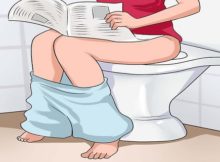While I know you’ve been successfully going to the bathroom for decades, it’s still likely you’re making some mistakes while pooping. Many people don’t allow themselves the time to have an ideal bathroom experience, which can lead to constipation and other health problems — as well as that nagging sense that you didn’t fully “go.”
And that can really put a damper on the day. “Although it’s not widely talked about, we all want better poop,” NYC-based registered nurse Rebecca Lee tells Bustle. Nobody wants to feel constipated or unclean after going to the bathroom. We all just want to get in, get out, and go on with our day feeling light as air.
So what does the most ideal bathroom experience look like? “[Bowel movements] should be once or twice a day, be banana shaped, and of a consistency that you barely need toilet paper,” says nutritionist Lisa Mair, of Ultimate Rejuvenation Cleanse.
Ideal stools like these are all thanks to a healthy lifestyle. “Eating a healthy, whole foods, plant-based diet, and staying hydrated makes elimination, quick, easy, neat, and pleasant.” Instead of, you know, a total struggle. Read on for some mistakes you might be making while going number two, as well as how to remedy the situation.
1. Waiting Too Long To Go
Barring some sort of extenuating circumstance — like being stuck on a bus — you should always find a bathroom the moment the urge strikes. “Every time you wait and hold it in, your colon reabsorbs more and more fluid from your stool,” says Lee. This causes your poop to become hardened, which can, in turn, lead to constipation and other health problems.
2. Not Going At The Same Time Each Day
There exist a lucky few who wake up, poop, and go on with their day. For the rest of us, our poop schedule is a total guessing game. If this is your life, it can help to train yourself to poop at certain times, such as first thing in the morning. “As soon as you wake up, drink two full glasses of water on an empty stomach. Leave about 20-30 minutes in between your water and breakfast. If your constipation isn’t too bad, you should be on the toilet in about 30-60 minutes,” Lee says. Do this every morning and it should create a routine.
3. Crunching Up And Sitting The Wrong Way
Unlike most of the world, our Western-style toilets require us to sit when we really should be squatting to poop. “Some experts say that squatting reduces straining, anal fistulas, hemorrhoids, and constipation,” Lee says. It also makes it easier to poop. “Squatting helps the Puborectalis muscle to open, and allows for a more complete emptying.” To emulate the rest of the world, buy a Squatty Potty or rest your feet on a stool so your knees are up higher. It should help move things along.
4. Not Eating Enough Fiber
If you’re struggling to go to the bathroom, it mean you need to add more fiber to your diet. “Fiber attracts water into your colon and helps flush everything through,” Mair says. “It also acts like a scrub brush for the intestines, keeping them sparkling clean.” Plan ahead and start eating more fiber — like vegetables and beans — and you should notice a big difference.
5. Forgetting To Drink Enough Water
In the same vein, make sure you stay hydrated so stool can move easily through your intestines. If you don’t, Mair tells me you may struggle with constipation or hard-to-pass bowel movements. And that’s no fun.
6. Not Noticing When Things Have Changed
Are you suddenly constipated? Or are there specks of blood in your stool? If you notice changes like these and don’t tell a doctor, you could be putting your health at risk. “In general, any noticeable change in one’s bowel movements is cause for concern,” says Dr. Andy Barnett, of Legacy Health – GoHealth Urgent Care. “A change in color or consistency, especially if you note the presence of blood, is a tell-tale sign that something is not quite right.”
7. Eating A Big Meal First Thing In The Morning
If you can, give yourself enough time each morning to wake up, drink some water, and go to the bathroom before you eat breakfast. “You will feel better, have a healthier gut, and be more regular if you allow yourself to have your first bowl movement of the day before really eating breakfast,” says holistic wellness coach Leah Lesesne, MA, CSP. “A cup of tea or coffee and maybe a piece of fruit are fine, but avoid heavier foods until after that trip to the restroom.”
8. Sitting On The Toilet For Ages
I’m pretty sure we’re all guilty of sitting on the toilet, whipping out our phones, and relaxing while trying to poop. But this habit can lead to health problems. “Not only is this a waste of time, sitting on the toilet has been known to cause hemorrhoids,” health and fitness professional Mike Kneuer tells Bustle. If you can’t go within a few minutes, get up and try again later. (And drink some water.)
9. Not Cleaning Up Properly
Of course your wipe after going to the bathroom. But it’s always a good idea to up your cleaning game. “I’m a big fan of chemical-free baby wipes for my first and last wipes,” says Kneuer. “In between I’ll use the softest two-ply toilet paper I can, but I always use baby wipes, too … Not only is it much more sanitary but [you’ll] feel confident and good when you have a clean butt.”
10. Straining Or Forcing Yourself To Go
Ever sit down on the toilet and try to force yourself to go? If so, you’re not alone. “A lot of people strain themselves trying to go when they don’t have to,” says Abbey Sharp, RD, a blogger at AbbeysKitchen.com. While it may feel like a good idea to get things moving, straining can lead to hemorrhoids and should be avoided at all costs.
11. Over-Wiping When The Deed Is Done
As Sharp tells me, wiping too much — especially with rough toilet paper — can lead to micro-tears that could cause infection. So keep all that scraping to a minimum. If you’re eating a healthy diet and drinking enough water, it should only take a few swipes (and maybe a baby wipe) before you’re good to go.
If your bowel movements are healthy, the whole bathroom process should be quick and painless. But if you notice anything odd, or have a hard time passing stool, be sure to talk with your doctor about possible causes.






